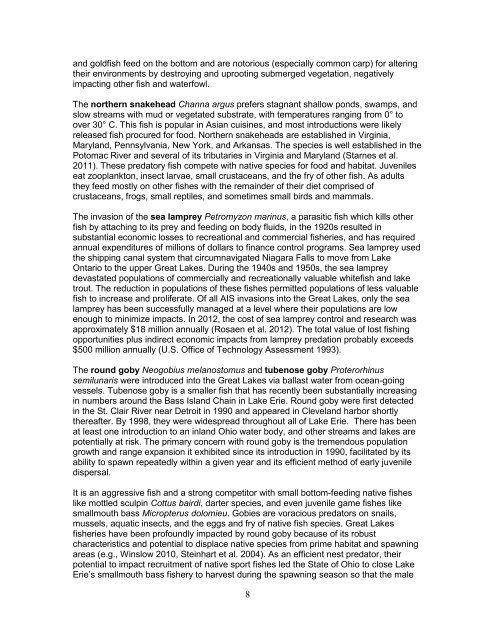State Management Plan for Aquatic Invasive Species Ohio ...
State Management Plan for Aquatic Invasive Species Ohio ...
State Management Plan for Aquatic Invasive Species Ohio ...
You also want an ePaper? Increase the reach of your titles
YUMPU automatically turns print PDFs into web optimized ePapers that Google loves.
and goldfish feed on the bottom and are notorious (especially common carp) <strong>for</strong> altering<br />
their environments by destroying and uprooting submerged vegetation, negatively<br />
impacting other fish and waterfowl.<br />
The northern snakehead Channa argus prefers stagnant shallow ponds, swamps, and<br />
slow streams with mud or vegetated substrate, with temperatures ranging from 0° to<br />
over 30° C. This fish is popular in Asian cuisines, and most introductions were likely<br />
released fish procured <strong>for</strong> food. Northern snakeheads are established in Virginia,<br />
Maryland, Pennsylvania, New York, and Arkansas. The species is well established in the<br />
Potomac River and several of its tributaries in Virginia and Maryland (Starnes et al.<br />
2011). These predatory fish compete with native species <strong>for</strong> food and habitat. Juveniles<br />
eat zooplankton, insect larvae, small crustaceans, and the fry of other fish. As adults<br />
they feed mostly on other fishes with the remainder of their diet comprised of<br />
crustaceans, frogs, small reptiles, and sometimes small birds and mammals.<br />
The invasion of the sea lamprey Petromyzon marinus, a parasitic fish which kills other<br />
fish by attaching to its prey and feeding on body fluids, in the 1920s resulted in<br />
substantial economic losses to recreational and commercial fisheries, and has required<br />
annual expenditures of millions of dollars to finance control programs. Sea lamprey used<br />
the shipping canal system that circumnavigated Niagara Falls to move from Lake<br />
Ontario to the upper Great Lakes. During the 1940s and 1950s, the sea lamprey<br />
devastated populations of commercially and recreationally valuable whitefish and lake<br />
trout. The reduction in populations of these fishes permitted populations of less valuable<br />
fish to increase and proliferate. Of all AIS invasions into the Great Lakes, only the sea<br />
lamprey has been successfully managed at a level where their populations are low<br />
enough to minimize impacts. In 2012, the cost of sea lamprey control and research was<br />
approximately $18 million annually (Rosaen et al. 2012). The total value of lost fishing<br />
opportunities plus indirect economic impacts from lamprey predation probably exceeds<br />
$500 million annually (U.S. Office of Technology Assessment 1993).<br />
The round goby Neogobius melanostomus and tubenose goby Proterorhinus<br />
semilunaris were introduced into the Great Lakes via ballast water from ocean-going<br />
vessels. Tubenose goby is a smaller fish that has recently been substantially increasing<br />
in numbers around the Bass Island Chain in Lake Erie. Round goby were first detected<br />
in the St. Clair River near Detroit in 1990 and appeared in Cleveland harbor shortly<br />
thereafter. By 1998, they were widespread throughout all of Lake Erie. There has been<br />
at least one introduction to an inland <strong>Ohio</strong> water body, and other streams and lakes are<br />
potentially at risk. The primary concern with round goby is the tremendous population<br />
growth and range expansion it exhibited since its introduction in 1990, facilitated by its<br />
ability to spawn repeatedly within a given year and its efficient method of early juvenile<br />
dispersal.<br />
It is an aggressive fish and a strong competitor with small bottom-feeding native fishes<br />
like mottled sculpin Cottus bairdi, darter species, and even juvenile game fishes like<br />
smallmouth bass Micropterus dolomieu. Gobies are voracious predators on snails,<br />
mussels, aquatic insects, and the eggs and fry of native fish species. Great Lakes<br />
fisheries have been profoundly impacted by round goby because of its robust<br />
characteristics and potential to displace native species from prime habitat and spawning<br />
areas (e.g., Winslow 2010, Steinhart et al. 2004). As an efficient nest predator, their<br />
potential to impact recruitment of native sport fishes led the <strong>State</strong> of <strong>Ohio</strong> to close Lake<br />
Erie’s smallmouth bass fishery to harvest during the spawning season so that the male<br />
8














